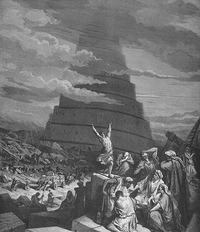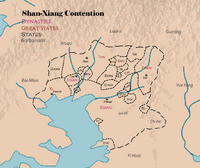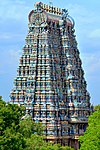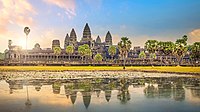Zohism

| Part of a series on |
| Zohism |
|---|
 |
Zohism (Xiaodongese: 鄒教 Zōujiao; lit. 'School of Zou'), also known as Shan (Xiaodongese: 禪教 Shàn-jiào) is one of the world's oldest continuously practiced religions. Zohism is a monistic faith, with elements of henotheism and atheism, centered on an eschatological cosmology dealing with self-salvation and spiritual liberation. It also encompasses a variety of traditions, beliefs and spiritual practices largely based on the original teachings of Soucius. It originated in ancient Xiaodong in the 8th century BCE, and, after a period of intense suppression, spread through much of South Coius, Satria and Southeast Coius. Three major extant branches of Zohism are generally recognized: Kuoeci (Xiaodongese: 觀鑒; lit. Seeing through the Mirror), Tsandau (Xiaodongese: 長道 Zhǎngdào; lit. Elder Way), and Dengoq (Xiaodongese: 臺樂; lit. Dancing on the Tower)
All Zohist schools share the goal of achieving self-actualisation and escaping the wheel of life and death, through the processes of Ciuqdoe (fracturing) and Zoqiaq (renewal), though they differ on the specifics and rites performed. They also vary in their interpretation of the path to self-liberation, and importance and canonicity ascribed to the various Zohist texts, and their specific teachings and practices. Widely observed practices include chanting the Zenyin, communal incantation, acts of penance and contrition, purging of the Tsui (vices, or sins), and cultivation of the Meteq (virtues, or perfections)
Zohism is believed to have began in the 7th century BCE as a reaction against the reigning philosophies. Despite intense persecution, Soucius and his followers were able to establish hidden and underground communities across Xiaodong. It soon attracted dissidents, inspiring numerous revolts against the Xiang dynasty. It was adopted by Emperor Min, along with Taoshi and Droitism, as part of his Threefold Heaven policy in 28 BC.
Zohism and Zohist ethics played a prominent role in the development of civilization in Southern Coius. Zohists have a widespread following in South Coius, and Southeast Coius. Significant Zohist communities can also be found in Satria, and the Asterias.
Terminology
Beliefs
Eschatology
Life after death is considered a major core of Zohist belief, as life is considered to be the first stage in the journey of self-actualisation and liberation. Eschatology in Zohism is a complex component concerning both the individual daily spiritual requirements for proper progress, and the greater collective destiny of humanity's transition to a higher realm.
Zohist eschatology is built upon a tripartite model. The model is considered to be artificially linear, due to the method of progression instituted by Soucius and Tsumin. The model itself is not considered to be artificial, however, despite containing artificial elements such as the Tower. It is a finite organic reality formed by the dreams of the Primordial Kon, with the model at the centre of this reality.
Abyss
The Abyss (Xiaodongese: 淵) is the first and greatest stratum. It is considered to be both a physical dimension and incorporeal reality, both of these natures combined in one indivisible physis. It is therefore accessed in two ways: physically transitioning via natural expiration, or by spiritually entering while in a zoetic state. Entering the Abyss after death is considered the normal route for the laity, while the latter, considered a more difficult method, is usually practised by the clergy.
The Abyss is composed of twelve layers, each smaller than the preceding layer. Each layer presents a different vice or sin that must be conquered before one can proceed to the next layer with each layer being comparatively more difficult. There is no set vice for each layer, with it relating to which vices one faced and the challenge being predetermined by how effectively one faced them. Death does not exist in the Abyss, as there is no way to transition except through inner conquest. This process is known as Ciuqdoe (決斷 lit. Fracturing), as one destroys their false sense of self and prepares a vessel for a new ego.
The final layer of the Abyss, the twelfth, is where one faces a great temptation. Failure to overcome the temptation sees spiritual annihilation, before being reincarnated on Earth. Conquering this temptation cleanses the vessel of all its impurities and unlocks the door to the Tower.
Tower

De (臺)
Paradise
Thi (天)
Divinities
Sagehood
A ti (帝) or sage has ascended the tower of De.
Tsumin

Tsumin (朱明) is a deistic figure who is considered to be a culture hero, trickster, demiurge, and hostile entity. He plays a complex role in Zohist mythology and cosmology, being both the driving force behind man's ability to escape reality, and the creator and maintainer of the system which traps them. In most accounts he is the primordial man, the first to achieve sentience, delve the Abyss and become a conscious, living Ti. He reshaped the world and built the Tower, before ascending to Paradise.
As a result of his fickle nature, Tsumin is rarely worshipped and is instead appeased through offerings and rituals. He is considered a bad omen, and the very mention of his name requires the recitation of the avowal or an ablution.
When depicted, which is rare, he is usually portrayed either as an early human with horns, wearing a rudimentary cloak of fur or leaves, or is portrayed as a dark or demonic warrior-king. His true name, a relic of the first language, is considered taboo. He is therefore usually referred to by his title 'Lord of the Dawn', such as the Xiaodongese Zhūmíng (lit. 'vermillion brightness') or Divali Bholānāth, or similar derivations. He is also known by a myriad of other titles and names.
Primordial Kon
The Primordial Kon (Xiaodongese: 魂) is the demiurge from which all reality was created. It was formed ex nihilo and is an ageless, formless being without thought or consciousness. From its essence was born Yì (異), and as a reaction to its essence was born È (惡). Yì is inseparably tied to the Kon, they are of the same nature and substance. Yì was born asleep, and it is from his thoughts that the godhead emanates all reality. All reality is therefore ultimately believed by Zohists to be the dream of the Primordial Kon.
The Primordial Kon is viewed a supreme source of energy and being, rather than an omnipotent deity. It is from this energy that all things within the dream, including reality, are sustained and given meaning. Though ageless, the act of creating reality has bound the Primordial Kon to a linear time structure and so it is not immortal. Zohists believe that eventually its energy will be spent and reality will fade when the dream ends.
Sefaan
Cosmology
Creation
Sylen (世輪)
Chi
-deep soul
Khin
-嶔
Practices
Avowal
This realm is an artifice, 此界機也
there dwells only the Abyss. 機唯淵也
I fall and am lost. 我踣之而蒙
The Abyss is an artifice, 淵為機也
there lies only the Tower. 機唯臺也
I ascend and am found. 我登之而明
The Tower is an artifice, 臺為機也
I am all. 全為我也
I forswear and am free 我釋之而釋
"Declaration of Soucius " (Xiaodongese: 鄒子真言)
The avowal, or Zenyin, is the basic creed of Zohism that should be recited under oath with the specific statement:
"The World is a lie, there is only the Abyss.
I must descend.
Through the descent, I am broken.
The Abyss is a lie, there is only the Tower.
I must ascend
Through the ascent, I am anew.
The Tower is a lie, there is only me.
When the lie is rejected, my chains are broken.
I am free."
The Zenyin is not necessary for conversion to Zohism, but it is an essential step for beginning one's journey into the Abyss. To become a Setse, one who has recited the creed, it must be witnessed, and attested for, by a monk. It may be recited in any language, though for attestation it is expected to be recited in Liturgical Xiaodongese
Incantation
Ablution

Ablution, known as Moqhioq (沐浴), is both a necessary facet of Zohist life and one of its most sacred rituals. It is a process of ritual purification by which a person cleanses themselves of impurities. It is divided into two components, the Phuthon (ordinary), and the Dabiq (special). The Phuthon Moqhioq, a partial wash involving washing the face, hands, and feet, is divided into the Rijian (diurnal), and the Huanhun (vespertine). The Rijian is performed at dawn or noon, while the Huanhun is at dusk or midnight. Barring a context that makes perfoming it impossible, it is compulsory for one ordinary ablution to be performed per day. The water used must have dwelt in light, either from the sun or moon, for at least an hour.
The Dabiq Moqhioq is performed once every year, on the Huantian, and is commonly performed at holy pool inside a Tsauzir. It is also performed for newborns three months after birth, and as a coming of age ceremony for girls at 12 and boys at 14. It is a full wash, involving complete submersion for five to ten seconds, and may be performed several times. The water used for the ceremony must include a drop from the Shuideng Cave, and must have a source of constant natural light. It is compulsory to have performed it at least once in a lifetime.
Contrition
Concatenation
Scriptures
History
Life of Soucius

Soucius (Xiaodongese: 鄒子 Zōuzǐ, "Master Zou" fl. 636-607) was active during the later stages of the Shan-Xiang Contention, with his birthdate traditionally considered to be 662 BCE. He came from Ren, a state on the Hongcha River subject to Tan, hailing from a mercantile shang family. The events of his earlier life are unknown historically, although it can be gathered that he attained a substantial education, and likely visited various states.
It is likely he quickly gathered a large following to his teachings, as in 636 his followers are mentioned in the Records of Guo. He became a known critic of the ruling philosophy of Shinism, and the Shensheng ("thunder-born") and Mengtian ("elder-heaven") religious philosophies. He viewed Shinism as too cynical and worldly, focused purely upon interstate relations and ruler etiquette without providing clear rules for society as a whole, and Shensheng and Mengtian as exclusive elite religions, allowing only the clergy to achieve salvation and impoverishing the common folk through exorbitant taxes to fund grandiose rituals.
For the next three decades he worked gathering a following, establishing schools, and in 619 found a convert in the new ruler of Tan, King Yu of Tan. He provided counsel to King Yu, advising him to gather a coalition of states against the Xiang. Yu did not heed his advice until it was too late, gathering only a small number of states in 613 for an ill-fated invasion. This resulted in the disastrous Battle of Gai'nan, after which Tan was forced to accept humiliating terms, and expel all Zohists from the realm. Soucius left for Xi, where he continued his work and advised its king, before he disappears from the record in 607. It is held by all three Zohist schools that he became a Ti and ascended. Records dating after his disappearance from the Early Xiang claim that he was captured and executed, along with thousands of his followers.
Early Zohism

In its early years Zohism found itself subject to intermittent persecutions of varying scales and severity. It found refuge and patrons in several realms, such as Xi, Ren, Tan, Jiang, and for a short period Zhan, but was unable to establish itself. Xiang's hegemony over the other states, especially after its conquest of the rump Shan state in 502 BCE, gave it the leverage to force other states to exile or execute Zohist officials and scholars. Xiang's rulers found Zohism anthithetical to their interests, preferring to patronise instead Taoshi and Droitism, both schools which had emerged from the collapse of Shinism's orthodoxy.
In 422 BCE, Emperor Cheng instituted policies designed to disadvantage Zohist converts, and encouraged persecution and pogroms of believers and clergy. These policies would be kept by his successors until redacted by Emperor Min in 28 BCE. These persecutions resulted in the first spread of Zohism, with refugees leaving for Baekjeong, Senria, and Satria to establish communities, and also in numerous rebellions and revolts against the Xiang. This hindered Xiang attempts to unify "tianxia", and to centralise power by reducing or annexing feudatories and vassal states. The persecutions also failed to stem the growth of Zohism.
Emperor Min's actions started a synthesis of Zohism, Taoshi, and Droitism. The latter largely ceased to exist as a separate philosophical school and became ingrained into Xiaodongese administrative and judicial practices, while Zohism and Taoshi became synonymous until the Neo-Taoshi reaction in the Tao dynasty.
Zohism and Xiaodongese dynasties
Spread to Satria and Southeast Coius
Demographics
Schools
Tsandau
- dominant in Xiaodong, Baekjeong, Kumuso, Siamat, eastern Satria
- organised clergy, headed by the Dashi. Organised into circuits, which routinely reorganised, now largely conform to modern borders with some exceptions.
- does not believe in salvation outside the Zohist faith, non-Zohists must convert or hope to be reborn Zohist
- main scriptures are: Laotze, tbd
Kuoeci
- dominant in Senria, western Satria, parts of Xiaodong.
- semi-organised clergy, some orders having less distinction between layperson and clergy.
- four main rough "leaders": the Guru in Satria, Tenzo in Senria, Jiexin (接心) in Xiaodong, and Aya Ini in Tava
- accepts salvation outside Zohist faith, but with limitations, and encourages conversion
- main scriptures are: Laotze, Shaotze, tbd
Dengoq
- dominant in Southeast Coius, eastern Great Steppe, parts of Xiaodong
- semi-organised clergy, though split between many different orders
- no real structure or leader(s), any icons largely based upon personalities and spirituality
- accepts salvation outside Zohist faith, believes all faiths are innately Zohist
- main scriptures are: Laotze, tbd



